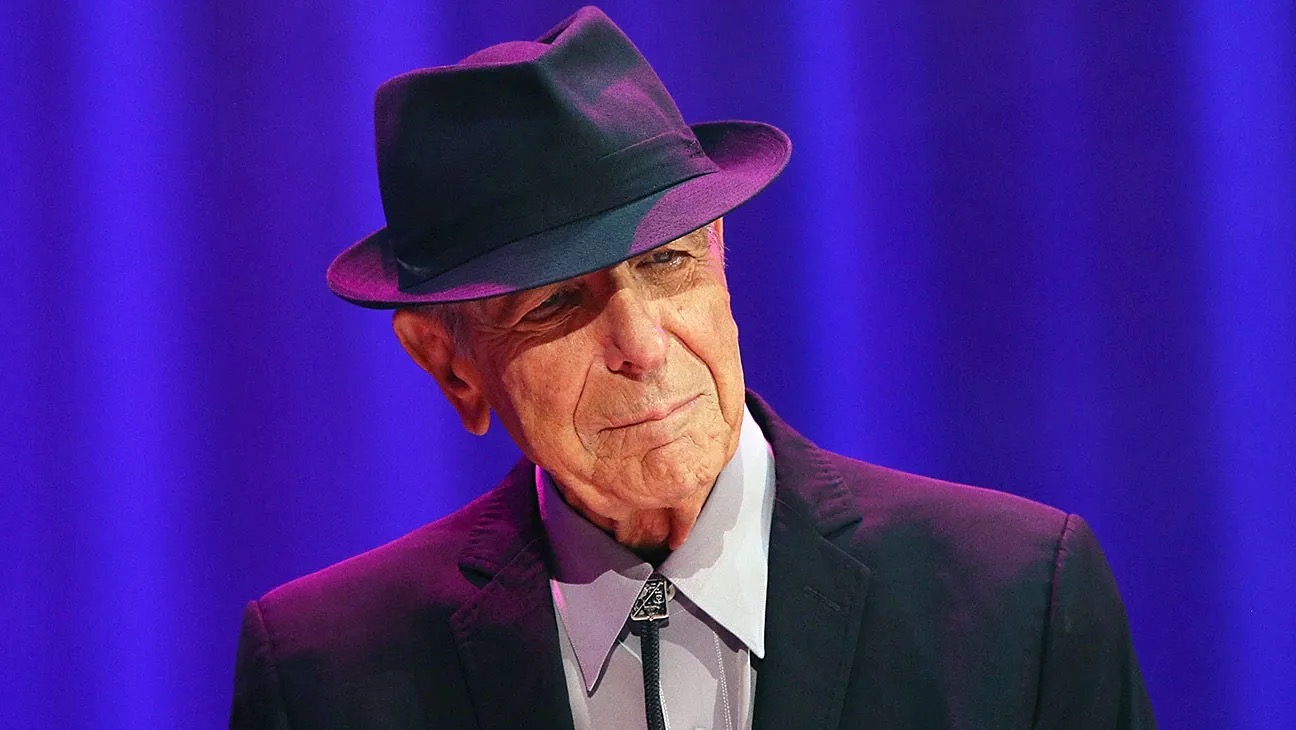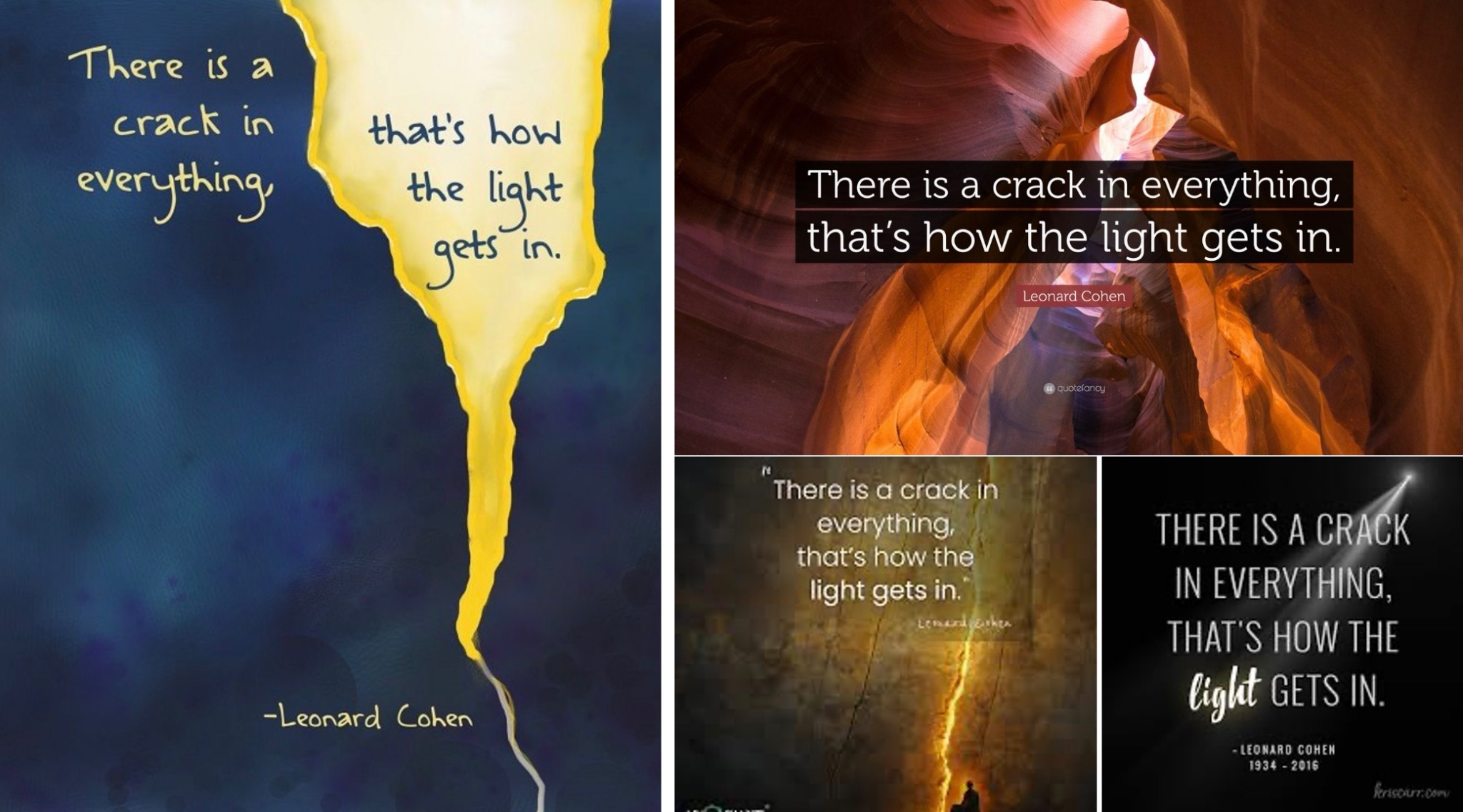
A Fresh Look at a Famous Leonard Cohen Lyric
Leonard Cohen’s most famous song might be “Hallelujah,” but his best-known and most quoted lyric comes from another tune, “Anthem,” the fifth track off his 1992 album “The Future.”
Here is that renowned lyric:
There is a crack in everything
That’s how the light gets in
In many ways, this is Cohen’s signature line, a standout among so many brilliant offerings. And even if you’re not a Cohen fanatic like me, you’ve undoubtedly seen the lyric before, probably plastered across someone’s social media feed.
It’s a beautiful line, and I’m a massive fan of it, just as I’m a fan of almost everything Cohen wrote and recorded during his lengthy and illustrious career. But I find the line incomplete because it’s only the second half of the “Anthem” chorus. The first half is usually left off.
That omission obscures an important message Cohen conveys with “Anthem”—at least the message I’m carrying with me as I grow older and seek purpose in these later years of life.
My latest blog for “A Fan’s Notes” is a meditation on Cohen’s famed lyric, offering a fresh look at the perfection of the entire passage and why it’s essential to the song’s message of hope, resilience, and perseverance.
‘That’s how the light gets in’
Unlike many of my previous posts, this blog doesn’t have a serendipitous backstory. I don’t recall what I was doing or even where I was living when I first heard “Anthem,” which Cohen released in 1992.
But Cohen’s music has been in my life for more than 30 years, and he is enshrined on my Mount Rushmore of musical artists, so he has been, and will remain, a frequent topic for these blogs.
The focus of today’s post, “Anthem” (click here for the complete lyrics), isn’t even a Top 20 Cohen song in my book, but its chorus ranks as one of his best lines. Before exploring the full lyric, however, let’s examine the part that’s become popularized to the point of almost being trite.
“There is a crack in everything, that’s how the light gets in” is so prevalent on Facebook and Instagram that it has become clichéd. I sometimes cringe when I see it used, because I’m quick to doubt the poster’s understanding of Cohen and the meaning behind his words. (Yes, I’m a Cohen snob.)
The quote often appears over an image depicting—you guessed it—a crack in a wall, ceiling, or other surface with rays of light shining through. Here are a few examples of what I mean:

Like I said, clichéd. And a little cheesy.
At the same time, I get it. The line is pithy, but the sentiment is profound. With just 12 words, Cohen speaks a philosophical and powerful truth about the human condition.
He creates a universal metaphor of how light, whether that’s kindness or love or beauty or salvation, finds its way into the darkness of our troubled lives and provides comfort when we need it most—namely, when we’re broken, vulnerable, defeated.
That “crack” in our lives might stem from grief, failure, loss, sickness, sadness, or suffering, and it can be overwhelmingly debilitating.
But if we’re lucky, then a partner’s love, or an uplifting song, or a divine revelation, or a visit from an old friend, or the practice of an art, or the nuzzle of a four-legged companion, or a connection with nature, or any number of other moving and magical and mystical things can find us, shine a light, and, if not completely heal us, at least make us feel human again.
This concept, especially as it relates to music, has been a recurring theme for “A Fan’s Notes” of late. As I grow older, any light that finds its way through the cracks and brings joy, however brief, becomes that much more significant and appreciated. I feel the need to honor it with these tributes, as I outlined in the introductory post for “A Fan’s Notes” more than a year ago.
All of which leads me to the often-omitted portion of the song’s chorus—something I believe is the most important lesson of “Anthem” and something I celebrate today.
A call to action
Without a doubt, “There is a crack in everything, that’s how the light gets in” stands alone as a powerful quote.
But while the more prominent passage from “Anthem” is beautifully constructed and deeply poetic, it also implies passivity: Everything may be flawed, but the light will find its way to you even if you do nothing.
The beginning of the song’s chorus, in comparison, is a rousing call to action—a command, a mantra, a reason for being.
Here it is:
Ring the bells that still can ring
Forget your perfect offering
In a nod to the song’s title, that line is rather … anthemic. And it’s reminiscent of other inspirational verse, like “Do not go gentle into that good night, rage, rage against the dying of the light,” as Welsh poet Dylan Thomas pleads to his dying father in that iconic poem.
When Cohen directs us to “ring the bells that still can ring, forget your perfect offering,” he’s instructing listeners not to give up and not to be passive but to act.
He implores us to overlook and even embrace our flaws, and then keep pushing, keep trying, keep living, keep doing what we love and what we do best, no matter how broken or imperfect we might feel. For there are still bells to ring, there is still a voice or a gift to share with the world.
This is what Cohen said about the lyric:
The future is no excuse for an abdication of your own personal responsibilities towards yourself and your job and your love. “Ring the bells that still can ring”: they’re few and far between but you can find them.
This situation does not admit of solution of perfection. This is not the place where you make things perfect, neither in your marriage, nor in your work, nor anything, nor your love of God, nor your love of family or country. The thing is imperfect.
I love that sentiment. Indeed, none of us and none of what we do is perfect. Far from it. But that shouldn’t stop us in the pursuit of our passions.
During the past several weeks, I needed that message.
After publishing my previous post in early July, a dear uncle of mine—the one who taught me to ski, among other things I loved about him—passed away after a long illness. My aging and ailing dog continued to decline. I was down on my job. And I continued struggling with regular bouts of malaise and melancholy.
Not surprisingly, my writing routine suffered as a result. With so many things weighing on me, the last thing I wanted to do at night was sit in front of my computer and put thoughts on the page that celebrated anything.
Thankfully, “Anthem” got me back on track. Listening to it provided the spark I needed to sit down, devote time to writing, and start ringing the bells once more. And it all began with an old video.
‘Ring the bells that still can ring’
The video that inspired me was Cohen performing “Anthem” during a 2008 concert in London. In this clip, Cohen acknowledges that the world is “plunged in darkness and chaos”—something we can all relate to these days—before he poignantly speaks the chorus and then performs the song.
It’s incredibly moving, in a way only he could manage, and I hope you’ll at least watch the first 40 seconds, if not all of it.
That video of an older, wiser Cohen perfectly embodies why I’m celebrating the chorus of “Anthem.” The same applies to the photo I chose of an older, wiser Cohen for this blog’s header image.
In 2008, Cohen decided to tour again at the age of 74 after a 15-year hiatus from performing. For six years, he traveled the world singing his greatest hits to adoring audiences. Sandy and I saw two of his shows in 2013, and they were life-changing.
Getting back on stage was partly so he could recoup monetary losses he had faced after a previous manager embezzled from him, but the decision was also rooted in something much deeper. He wondered if he could still, all these years later, fill auditoriums of fans eager to see him sing hits like “Suzanne,” “So Long, Marianne,” “Hallelujah,” and, of course, “Anthem.”
Was Cohen as spry as he was 30 years earlier? Not quite, though he often skipped across the stage between sets and showed remarkable energy while performing. He exceeded everyone’s expectations, perhaps even his own.
His decision to perform again was an inspiration. It still is, even 12 years after seeing him in concert and nine years after he died.
While writing this piece, itself imperfect, as my blogs usually are, I concluded these tours were his way of ringing the bells that still can ring. Despite his age and time away from touring, he put aside any notion of a perfect offering—though the shows were transcendent in their own way—and, in turn, provided light for so many others, me included.
I’ve been a fan of Leonard Cohen and have loved his music, as well as the message behind the whole chorus of “Anthem,” for a long, long time.
And because of that passage’s ability to inspire and encourage living life to its fullest—even when all else seems hopeless and lost—I’m certain I’ll be a fan until the bells no longer ring.

Post a comment